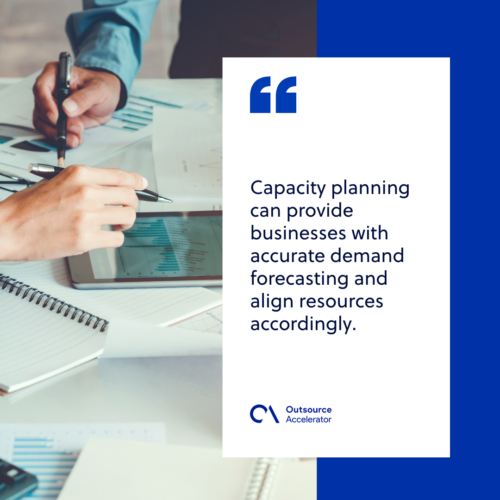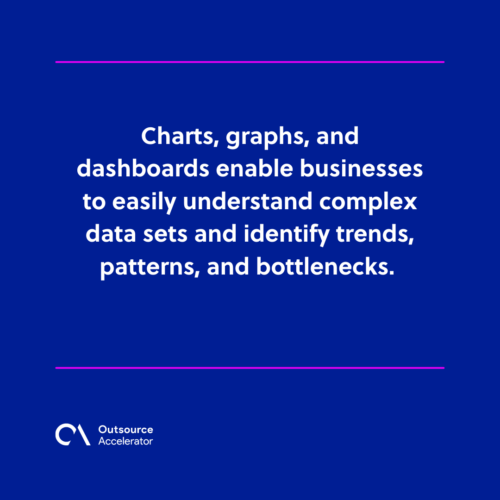How to develop a successful capacity planning strategy for business

Resource management directly impacts businesses’ overall performance, profitability, and competitiveness in the market.
When businesses fail to have an effective management system, they face several challenges and negative consequences. Inefficient resource management, for example, can lead to unnecessary costs and wastage.
Without proper management and control, resources such as materials, equipment, and labor may be underutilized or misallocated.
This results in increased expenses, reduced productivity, and decreased profitability.
Inefficient resource utilization also hampers the ability to optimize operations and deliver products or services in a timely manner.
This leads to dissatisfied customers and potential loss of business.
In this regard, a well-executed capacity planning strategy allows businesses to effectively manage resources, minimize costs, and maintain high levels of client satisfaction.
This article covers how to set up successful capacity planning, its types, and the tools used in developing the strategy to ensure smooth business operations.
Role of capacity planning in businesses
Capacity planning helps organizations align their resources with anticipated demand, enabling them to do the following:
- Optimize production levels
- Manage inventory effectively
- Meet customer expectations
Here are the significant roles and aims of capacity planning:
- Customer satisfaction. Capacity planning ensures that businesses can meet customer demands promptly and efficiently by reducing the risk of stockouts or long waiting times.
- Cost optimization. Capacity planning can provide businesses with accurate demand forecasting and align resources accordingly. It reduces inventory costs, avoids excess capacity, and optimizes operational expenses.
- Enhanced efficiency. Businesses can streamline their operations, eliminate bottlenecks, and allocate resources efficiently through effective capacity planning.
- Strategic decision-making. With robust capacity planning strategies, businesses can make informed decisions regarding expansion and resource allocation, supporting long-term growth and profitability.
Effective capacity planning strategies involve forecasting future needs based on historical data and market trends, allowing businesses to adjust resources accordingly.

8 types of capacity planning
Capacity planning is categorized into eight different types, each serving a specific purpose in managing resources effectively:
1. Strategic capacity
Strategic capacity planning focuses on long-term goals and aligning resources with the organization’s objectives.
It involves analyzing market trends and growth projections and making decisions that position the business for future success.
For example, a startup technology company may forecast increasing demand for particular software applications.
At the same time, it can invest in research and development to enhance its capabilities.
By proactively planning and allocating resources based on strategic considerations, companies can maintain a competitive advantage in the market.
2. Tactical capacity
Tactical capacity planning aims to balance resource utilization and responsiveness to market dynamics.
A hotel may analyze historical booking patterns and upcoming events in the area to determine the optimal number of rooms to allocate for different periods.
Through tactical capacity, enterprises can optimize their operations and effectively handle short-term variations in demand without overcommitting or underutilizing resources.
3. Operational capacity
Operational capacity planning involves managing labor, equipment, and inventory to meet immediate demand.
For example, a contact center may assess call volume patterns throughout the day and allocate the appropriate number of agents to handle the expected call flow during peak hours.
Businesses can maintain operational efficiency, minimize wait times, and deliver products or services promptly, resulting in increased positive reviews.
4. Lead capacity
This capacity planning aims to stay ahead of market requirements and avoid capacity constraints that could hinder business operations.
For instance, a solar panel manufacturer may invest in additional production lines and skilled labor to meet the expected increase in demand due to growing environmental awareness.
To ensure smooth operations and optimize resources, it becomes essential to engage in tool capacity planning.
5. Lag capacity
Lag capacity planning involves adding operational and workforce capacity even after an increased demand has already occurred.
While it may be a reactive approach, it is sometimes necessary for unexpected demand growth.
For instance, a food delivery service may experience a sudden surge in orders during a promotional campaign.
The company may need to quickly scale up its fleet of delivery drivers to meet the increased demand.
6. Expansion capacity
Expansion capacity planning focuses on adding resources to accommodate increased production volumes. It involves investing in additional equipment, facilities, or labor to support business growth.
For example, a beverage manufacturer experiencing growing demand for its products may invest in new production lines and expand its manufacturing plant to increase its production capacity.
This type of capacity planning can avoid production bottlenecks, maintain product quality, and meet customer expectations, ultimately supporting their growth trajectory.
7. Optimization capacity
Optimization capacity planning aims to maximize the utilization of existing resources through process improvements, automation, and efficiency enhancements.

It involves the following process:
- Analyzing current operations
- Identifying bottlenecks
- Implementing newer strategy (within existing strategies)
- Optimize resource allocation
By continuously improving processes and streamlining operations, firms can maximize their existing capacity and achieve higher productivity and profitability.
8. Contingency capacity
Contingency capacity planning involves preparing for unforeseen events or disruptions impacting business operations.
It includes developing backup plans and alternative sourcing strategies.
For example, a retail store may maintain additional inventory in a secondary warehouse to quickly restock shelves during supply chain disruptions.
Capacity planning: Step-by-step process
Developing successful capacity planning strategies involves a systematic approach. Here are the key steps to follow:
Step 1: Demand forecasting and analysis
This first step allows you to align your firm’s capacity planning efforts to meet future requirements.
Utilize historical data, market trends, customer behavior, and industry insights to develop a robust demand forecast.
Conduct a thorough analysis to understand demand patterns, identify seasonality or trends, and anticipate changes in customer needs.
Demand forecasting and analysis play a crucial role in project planning by providing invaluable insights into future trends and market dynamics.
Step 2: Evaluation of current capacity
Evaluate the existing capacity of your business across various dimensions and areas of inefficiency that may hinder meeting future demand.
This evaluation provides a baseline for determining current capacity adequacy and helps identify improvement areas.
Understanding customer demand trends is crucial for aligning capacity with market needs, optimizing resources, and delivering high-quality products or services promptly.
Step 3: Gap analysis and setting capacity targets
Compare the forecasted demand with the evaluated current capacity to identify gaps. Then conduct a gap analysis to understand the extent of capacity shortfall or excess.
Based on this analysis, set realistic but clear capacity targets that align with business goals.
Clear capacity targets provide a roadmap for future planning and resource allocation.
Step 4: Developing capacity strategies
Through the identified gaps and capacity targets, develop strategies that may involve a combination of approaches, such as:
- Expanding facilities
- Investing in new equipment or technology
- Optimizing processes
- Adjusting workforce levels
Assess each strategy’s feasibility, costs, and potential risks, and prioritize actions that offer the most cost-effective and impactful solutions.
This ensures that resources are allocated efficiently to meet the projected demand while optimizing operational performance.
Step 5: Implementation and monitoring
Implement the capacity strategies developed in the previous step and closely monitor their effectiveness.
Continuously track key performance indicators (KPIs) such as resource capacity, customer satisfaction, production output, budget, and cost efficiency.
You should also monitor market dynamics, customer demands, and changes in business conditions to identify the need for adjustments or realignment of capacity plans.
Tools used in capacity planning
Several tools and technologies can aid businesses in capacity planning. Here are some commonly used tools:
Demand forecasting tools
Demand forecasting tools are used in capacity planning to create projections that assist firms in making educated decisions about capacity allocation and resource planning.
This is done by examining historical sales data, consumer behavior, economic indicators, and market trends.
A retail operator, for example, might utilize demand forecasting tools to predict seasonal demand swings and adjust inventory levels accordingly.
Capacity management software
Capacity management software is a powerful tool that provides businesses with a comprehensive platform for managing and optimizing their capacity planning processes.
This software provides the following features throughout the capacity planning process:
- Efficient resource allocation
- Demand forecasting
- Scenario modeling
- Performance tracking
Capacity management software is also used to identify areas of improvement in inventory management.
Moreover, this process also streamlines and enhances collaboration among teams and provides real-time insights to optimize resource allocation.
Workforce management systems
Workforce management systems are valuable tools in capacity planning as they help enterprises align their workforce with anticipated demand.
These systems provide functionalities for employee scheduling, labor optimization, skill matching, and tracking workforce performance.
A lead strategy in workforce management involves forecasting staffing needs using historical data and real-time analysis, ensuring skilled employees are available at the right time.
With resource management tools, businesses can assign workforce efficiently, balancing workloads and boosting productivity.
Visualization tools
Visualization tools provide a visual representation of capacity-related data.
Charts, graphs, and dashboards enable businesses to easily understand complex data sets and identify trends, patterns, and bottlenecks.
These tools also help companies identify areas of overutilization or underutilization, allowing them to take proactive measures to optimize capacity.

Project management software
Project management software plays a significant role in capacity planning, particularly for capacity-related projects such as facility expansions or process improvements.
This software provides the following functionalities for planning and tracking projects:
- Resource allocation system
- Timeline management
- Collaboration portals
- Real-time tracking system
As such, businesses can use project management software to plan and coordinate capacity-related initiatives, ensuring timely project completion.
Capacity planning in a nutshell
Capacity planning helps firms to efficiently manage resources, satisfy client requests, and carry out daily operations.
Businesses may create effective capacity planning strategies that align with their objectives and guarantee long-term performance.
They should be able to understand the overall function of capacity planning.
If you want to try capacity planning for your business operations, follow its step-by-step process and use relevant tools.
Workforce capacity planning is a crucial aspect of overall capacity planning for organizations.







 Independent
Independent




